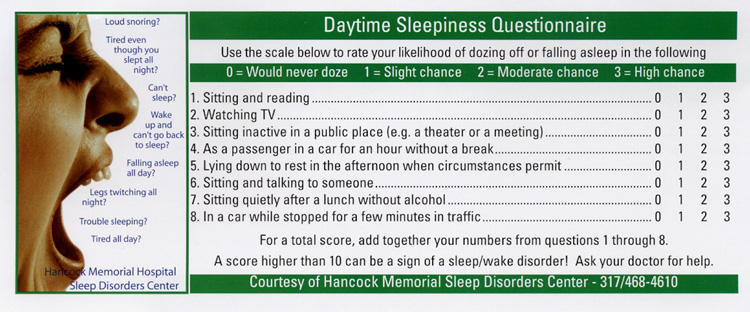|
Many medical professionals believe adequate nutrition, stress management, and sleep are the 3 most important considerations in the maintenance of good health. An estimated 62% of the US population can experience sleep problems, yet approximately 80% of US adults have never discussed sleep or sleep problems with their physicians. This may largely be due to the stigma that sleepiness equates with laziness.
Humans experience two main types of sleep: rapid eye movement (REM) sleep, which is dream sleep and non-REM (NREM) sleep. NREM or slow-wave sleep is characterized by 4 main stages, ranging from light sleep (stages 1 and 2) to deep sleep (stages 3 and 4). In Stage 1, sleep is a light sleep from which the sleeper may be easily aroused by moderate stimuli or even by neck jerks. This is followed by a rapid progression (between 10 and 25 minutes) through stages 2, 3, and 4 of NREM sleep. Stage 2 sleep is true sleep and is observed as a deeper sleep than stage 1. Stages 3 and 4 are deep sleep, and in stage 4, activation and arousal only occur with vigorous stimulation. If awakened from stage 4, a person does not report dreaming. REM sleep follows completion of stage 4 sleep. Dreaming, rapid eye movements behind closed eyelids, and a marked increase in brain oxygen consumption characterize REM sleep.
In NREM sleep, there is also an inactivation of short-term memory, thought processes wander and become random in a dreamlike fashion. There is release of growth hormone and gonadotropins from the pituitary gland and decreases in blood pressure, heart rate, and respiratory rate. Based on these changes, some researchers speculate that NREM may serve as a time of the body’s rest and metabolic restoration.
In contrast, REM sleep is associated with an increase and irregularity in blood pressure, heart rate, and respiratory rate. REM sleep is thought to be an active functional state of the brain. We dream in REM sleep. REM sleep appears to facilitate long-term chemical and structural changes that the brain must undergo to make learning and memory possible.
Common Sleep Disorders
Sleep apnea is a serious, potentially life-threatening condition that is far more common than generally understood. First described in 1965, sleep apnea is a breathing disorder characterized by interruptions of breathing during sleep. It owes its name to a Greek word, apnea, meaning "want of breath."
There are two types of sleep apnea: central and obstuctive. Central sleep apnea, which is less common, occurs when the brain fails to send the appropriate signals to the breathing muscles to start respirations. Obstructive sleep apnea is far more common and occurs when air cannot flow adequately into or out of the person's nose or mouth although efforts to breathe continue. This is the most common sleep disorder seen in a sleep lab.
These apneas are almost always accompanied by snoring between apnea episodes, although not everyone who snores has this condition. Sleep apnea can also be characterized by choking sensations. Frequent interuptions of deep, restorative sleep often lead to early morning headaches and the most common symptom seen, excessive daytime sleepiness. In a given night, the number of involuntary breathing pauses or "apneic events" may be as high as 20 to 30 or more per hour.
Because of the serious disturbances in their normal sleep patterns, people with sleep apnea often feel very sleepy during the day and their concentration and daytime performance suffer. The consequences of sleep apnea range from annoying to life-threatening. They include depression, irritability, sexual dysfunction, learning and memory difficulties, and falling asleep while at work, on the phone, or driving. Early recognition and treatment of sleep apnea is important because it may be associated with irregular heartbeat, high blood pressure, heart attack, and stroke.
Nasal continuous positive airway pressure (CPAP) is the most common effective treatment for sleep apnea. In this procedure, the patient wears a mask over the nose during sleep, this helps keep the airway open. The air pressure is adjusted so that it is just enought to deep the airway open and provide adequate breathing.
Some patients with sleep apnea may need surgery. Although several surgical procedures are used to increase the size of the airway, none of them is completely successful or without risks. More than one procedure may need to be tried before the patient realizes any benefits.
Narcolepsy, a less common problem, is a chronic neurologic disorder that is characterized by failure to mintain normal boundaries between sleep and the waking state coupled with an inablility to maintain normal wakefulness and sleep. This manifests through a constellation of clinical symptons of varying frequency and severity. The most prevalent sympton is excessive daytime sleepiness, which occurs in 100% of patients diagnosed with narcolepsy. Cataplexy, spells of muscle weakness often related to emotion, is the second most common sympton, occuring in 60% to 100% of patients. During cataplexy the person can fall, feel weak, and may need to sit or lie down. Spells typically last a few minutes. Often Narcolepsy is difficult to diagnose and goes unrecognized for many years. Treatment with medication is often very effective.
For more information call or email the Hancock Memorial Sleep Disorder Center at 317-468-4610 or sleepcenter@hmhhs.org.
View Segment
and take this quiz to see if you have a sleep disorder.

Randy Campbell, RPsgT
Coordinator
Hancock Memorial Sleep Disorders Center
Michael Levine MD
Certified Sleep Specialist
Director Hancock Memorial Sleep Disorder Center
|